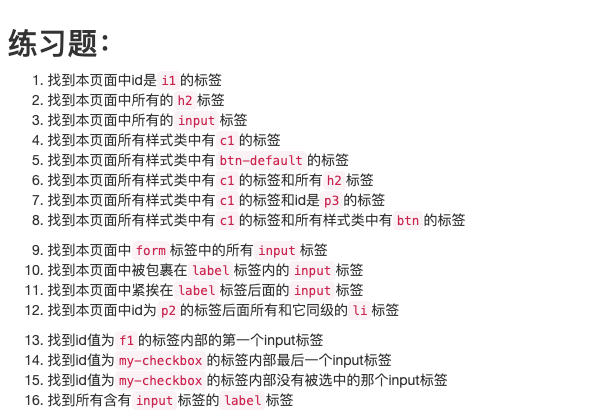一、jQuery操作标签
1、jQuery练习题

练习题操作页面网址:file:///Users/mac/Desktop/%E8%80%81%E7%94%B7%E5%AD%A9%E8%AF%BE%E4%BB%B6/day57/jQuery%E7%BB%83%E4%B9%A0%E9%A2%98.html
$('#i1')
r.fn.init [div#i1.container]
$('h2')
r.fn.init [h2, prevObject: r.fn.init(1)]
$('input')
r.fn.init(9) [input#exampleInputEmail1.form-control, input#exampleInputPassword1.form-control, input#exampleInputFile, input, input, input, input, input#optionsRadios1, input#optionsRadios2, prevObject: r.fn.init(1)]
$('.c1')
r.fn.init(2) [h1.c1, h1.c1, prevObject: r.fn.init(1)]
$('.btn-default')
r.fn.init [button#btnSubmit.btn.btn-default, prevObject: r.fn.init(1)]
$('.c1,h2')
r.fn.init(3) [h1.c1, h1.c1, h2, prevObject: r.fn.init(1)]
$('.c1,#p3')
r.fn.init(3) [h1.c1, h1.c1, p#p3.divider, prevObject: r.fn.init(1)]
$('.c1,.btn')
r.fn.init(11) [h1.c1, h1.c1, a.btn.btn-primary.btn-lg, button.btn.btn-warning, button.btn.btn-danger, button.btn.btn-warning, button.btn.btn-danger, button.btn.btn-warning, button.btn.btn-danger, button#btnSubmit.btn.btn-default, a.btn.btn-success, prevObject: r.fn.init(1)]
$('form').find('input')
r.fn.init(3) [input#exampleInputEmail1.form-control, input#exampleInputPassword1.form-control, input#exampleInputFile, prevObject: r.fn.init(1)]
$('label input')
r.fn.init(6) [input, input, input, input, input#optionsRadios1, input#optionsRadios2, prevObject: r.fn.init(1)]
$('label+input')
r.fn.init(3) [input#exampleInputEmail1.form-control, input#exampleInputPassword1.form-control, input#exampleInputFile, prevObject: r.fn.init(1)]
$('#p2~li')
r.fn.init(8) [li, li, li, li, li, li, li, li, prevObject: r.fn.init(1)]
$('#f1 input:first')
r.fn.init [input#exampleInputEmail1.form-control, prevObject: r.fn.init(1)]
$('#my-checkbox input:last')
r.fn.init [input, prevObject: r.fn.init(1)]
$('#my-checkbox input[checked!="checked"]')
r.fn.init(3) [input, input, input, prevObject: r.fn.init(1)]0: input1: input2: inputlength: 3prevObject: r.fn.init [document]__proto__: Object(0)
$('label:has("input")')
r.fn.init(6) [label, label, label, label, label, label, prevObject: r.fn.init(1)]
2、操作标签
# 操作类
"""
js版本 jQuery版本
classList.add() addClass()
classList.remove() removeClass()
classList.contains() hasClass()
classList.toggle() toggleClass()
"""
# css操作
<p>111</p>
<p>222</p>
"""一行代码将第一个p标签变成红色第二个p标签变成绿色"""
$('p').first().css('color','red').next().css('color','green')
# jQuery的链式操作 使用jQuery可以做到一行代码操作很多标签
# jQuery对象调用jQuery方法之后返回的还是当前jQuery对象 也就可以继续调用其他方法
class MyClass(object):
def func1(self):
print('func1')
return self
def func2(self):
print('func2')
return self
obj = MyClass()
obj.func1().func2()
# 位置操作
offset() # 相对于浏览器窗口
position() # 相对于父标签
# 位置操作
offset() # 相对于浏览器窗口
position() # 相对于父标签
scrollTop() # 需要掌握 右边滑动条距离顶部的距离
$(window).scrollTop()
0
$(window).scrollTop()
969
$(window).scrollTop() # 括号内不加参数就是获取
1733
$(window).scrollTop(0) # 加了参数就是设置
n.fn.init [Window]
$(window).scrollTop(500)
n.fn.init [Window]
scrollLeft() #滑动条距离左边的距离
# 尺寸
$('p').height() # 文本的高度
20
$('p').width() #文本的宽度
1670
$('p').innerHeight() # 文本+padding
26
$('p').innerWidth()
1674
$('p').outerHeight() # 文本+padding+border
26
$('p').outerWidth()
1674
# 文本操作
"""
操作标签内部文本
js jQuery
innerText text() 括号内不加参数就是获取加了就是设置
innerHTML html()
$('div').text()
"
有些话听听就过去了,不要在意,都是成年人!
"
$('div').html()
"
<p>
有些话听听就过去了,不要在意,都是成年人!
</p>
"
$('div').text('你们都是我的大宝贝')
w.fn.init [div, prevObject: w.fn.init(1)]
$('div').html('你个臭妹妹')
w.fn.init [div, prevObject: w.fn.init(1)]
$('div').text('<h1>你们都是我的大宝贝</h1>')
w.fn.init [div, prevObject: w.fn.init(1)]
$('div').html('<h1>你个臭妹妹</h1>')
w.fn.init [div, prevObject: w.fn.init(1)]
"""
# 获取值操作
"""
js jQuery
.value .val()
"""
$('#d1').val()
"sasdasdsadsadad"
$('#d1').val('520快乐') # 括号内不加参数就是获取加了就是设置
w.fn.init [input#d1]
$('#d2').val()
"C:fakepath�1_测试路由.png"
$('#d2')[0].files[0] # 牢记两个对象之间的转换
File {name: "01_测试路由.png", lastModified: 1557043083000, lastModifiedDate: Sun May 05 2019 15:58:03 GMT+0800 (中国标准时间), webkitRelativePath: "", size: 28733, …}
# 属性操作
"""
js中 jQuery
setAttribute() attr(name,value)
getAttribute() attr(name)
removeAttribute() removeAttr(name)
在用变量存储对象的时候 js中推荐使用
XXXEle 标签对象
jQuery中推荐使用
$XXXEle jQuery对象
"""
let $pEle = $('p')
undefined
$pEle.attr('id')
"d1"
$pEle.attr('class')
undefined
$pEle.attr('class','c1')
w.fn.init [p#d1.c1, prevObject: w.fn.init(1)]
$pEle.attr('id','id666')
w.fn.init [p#id666.c1, prevObject: w.fn.init(1)]
$pEle.attr('password','jason123')
w.fn.init [p#id666.c1, prevObject: w.fn.init(1)]
$pEle.removeAttr('password')
w.fn.init [p#id666.c1, prevObject: w.fn.init(1)]
"""
对于标签上有的能够看到的属性和自定义属性用attr
对于返回布尔值比如checkbox radio option是否被选中用prop
"""
$('#d3').attr('checked')
"checked"
$('#d2').attr('checked')
undefined
$('#d2').attr('checked')
undefined
$('#d4').attr('checked')
undefined
$('#d3').attr('checked')
"checked"
$('#d3').attr('checked','checked') # 无效
w.fn.init [input#d3]
$('#d2').prop('checked')
false
$('#d2').prop('checked')
true
$('#d3').prop('checked',true)
w.fn.init [input#d3]
$('#d3').prop('checked',false)
w.fn.init [input#d3]
# 文档处理
"""
js jQuery
createElement('p') $('<p>')
appendChild() append()
"""
let $pEle = $('<p>')
$pEle.text('你好啊 草莓要不要来几个?')
$pEle.attr('id','d1')
$('#d1').append($pEle) # 内部尾部追加
$pEle.appendTo($('#d1'))
$('#d1').prepend($pEle) # 内部头部追加
w.fn.init [div#d1]
$pEle.prependTo($('#d1'))
w.fn.init [p#d1, prevObject: w.fn.init(1)]
$('#d2').after($pEle) # 放在某个标签后面
w.fn.init [p#d2]
$pEle.insertAfter($('#d1'))
$('#d1').before($pEle)
w.fn.init [div#d1]
$pEle.insertBefore($('#d2'))
$('#d1').remove() # 将标签从DOM树中删除
w.fn.init [div#d1]
$('#d1').empty() # 清空标签内部所有的内容
w.fn.init [div#d1]
二、事件
// 第一种
$('#d1').click(function () {
alert('别说话 吻我')
});
// 第二种(功能更加强大 还支持事件委托)
$('#d2').on('click',function () {
alert('借我钱买草莓 后面还你')
})
-
克隆事件
<button id="d1">屠龙宝刀,点击就送</button>
<script>
$('#d1').on('click',function () {
// console.log(this) // this指代是当前被操作的标签对象
// $(this).clone().insertAfter($('body')) // clone默认情况下只克隆html和css 不克隆事件
$(this).clone(true).insertAfter($('body')) // 括号内加true即可克隆事件
})
</script>
-
自定义模态框
"""
模态框内部本质就是给标签移除或者添加上hide属性
"""
-
左侧菜单
<script>
$('.title').click(function () {
// 先给所有的items加hide
$('.items').addClass('hide')
// 然后将被点击标签内部的hide移除
$(this).children().removeClass('hide')
})
</script>
<!--尝试用一行代码搞定上面的操作-->
-
返回顶部
<script>
$(window).scroll(function () {
if($(window).scrollTop() > 300){
$('#d1').removeClass('hide')
}else{
$('#d1').addClass('hide')
}
})
</script>
-
自定义登陆校验
# 在获取用户的用户名和密码的时候 用户如果没有填写 应该给用户展示提示信息
<p>username:
<input type="text" id="username">
<span style="color: red"></span>
</p>
<p>password:
<input type="text" id="password">
<span style="color: red"></span>
</p>
<button id="d1">提交</button>
<script>
let $userName = $('#username')
let $passWord = $('#password')
$('#d1').click(function () {
// 获取用户输入的用户名和密码 做校验
let userName = $userName.val()
let passWord = $passWord.val()
if (!userName){
$userName.next().text("用户名不能为空")
}
if (!passWord){
$passWord.next().text('密码不能为空')
}
})
$('input').focus(function () {
$(this).next().text('')
})
</script>
- ###input实时监控
```python
<input type="text" id="d1">
<script>
$('#d1').on('input',function () {
console.log(this.value)
})
</script>
-
hover事件
<script>
// $("#d1").hover(function () { // 鼠标悬浮 + 鼠标移开
// alert(123)
// })
$('#d1').hover(
function () {
alert('我来了') // 悬浮
},
function () {
alert('我溜了') // 移开
}
)
</script>
-
键盘按键按下事件
<script>
$(window).keydown(function (event) {
console.log(event.keyCode)
if (event.keyCode === 16){
alert('你按了shift键')
}
})
</script>
-
阻止后续事件执行
<script>
$('#d2').click(function (e) {
$('#d1').text('宝贝 你能看到我吗?')
// 阻止标签后续事件的执行 方式1
// return false
// 阻止标签后续事件的执行 方式2
// e.preventDefault()
})
</script>
<script>
$('#d1').click(function () {
alert('div')
})
$('#d2').click(function () {
alert('p')
})
$('#d3').click(function (e) {
alert('span')
// 阻止事件冒泡的方式1
// return false
// 阻止事件冒泡的方式2
// e.stopPropagation()
})
</script>
<button>是兄弟,就来砍我!!!</button>
<script>
// 给页面上所有的button标签绑定点击事件
// $('button').click(function () { // 无法影响到动态创建的标签
// alert(123)
// })
// 事件委托
$('body').on('click','button',function () {
alert(123) // 在指定的范围内 将事件委托给某个标签 无论该标签是事先写好的还是后面动态创建的
})
</script>
# 等待页面加载完毕再执行代码
window.onload = function(){
// js代码
}
"""jQuery中等待页面加载完毕"""
# 第一种
$(document).ready(function(){
// js代码
})
# 第二种
$(function(){
// js代码
})
# 第三种
"""直接写在body内部最下方"""
$('#d1').hide(5000) #逐渐隐藏
w.fn.init [div#d1]
$('#d1').show(5000) #逐渐显示
w.fn.init [div#d1]
$('#d1').slideUp(5000) #向上消失
w.fn.init [div#d1]
$('#d1').slideDown(5000) #向下消失
w.fn.init [div#d1]
$('#d1').fadeOut(5000) #渐变从有到无
w.fn.init [div#d1]
$('#d1').fadeIn(5000) #渐变从无到有
w.fn.init [div#d1]
$('#d1').fadeTo(5000,0.4) #渐变到某一个透明度就停
w.fn.init [div#d1]
# each()
# 第一种方式
$('div')
w.fn.init(10) [div, div, div, div, div, div, div, div, div, div, prevObject: w.fn.init(1)]
$('div').each(function(index){console.log(index)})
VM181:1 0
VM181:1 1
VM181:1 2
VM181:1 3
VM181:1 4
VM181:1 5
VM181:1 6
VM181:1 7
VM181:1 8
VM181:1 9
$('div').each(function(index,obj){console.log(index,obj)})
VM243:1 0 <div>1</div>
VM243:1 1 <div>2</div>
VM243:1 2 <div>3</div>
VM243:1 3 <div>4</div>
VM243:1 4 <div>5</div>
VM243:1 5 <div>6</div>
VM243:1 6 <div>7</div>
VM243:1 7 <div>8</div>
VM243:1 8 <div>9</div>
VM243:1 9 <div>10</div>
# 第二种方式
$.each([111,222,333],function(index,obj){console.log(index,obj)})
VM484:1 0 111
VM484:1 1 222
VM484:1 2 333
(3) [111, 222, 333]
"""
有了each之后 就无需自己写for循环了 用它更加的方便
"""
# data()
"""
能够让标签帮我们存储数据 并且用户肉眼看不见
"""
$('div').data('info','回来吧,我原谅你了!')
w.fn.init(10) [div#d1, div, div, div, div, div, div, div, div, div, prevObject: w.fn.init(1)]
$('div').first().data('info')
"回来吧,我原谅你了!"
$('div').last().data('info')
"回来吧,我原谅你了!"
$('div').first().data('xxx')
undefined
$('div').first().removeData('info') #删除这个
w.fn.init [div#d1, prevObject: w.fn.init(10)]
$('div').first().data('info')
undefined
$('div').last().data('info')
"回来吧,我原谅你了!"
